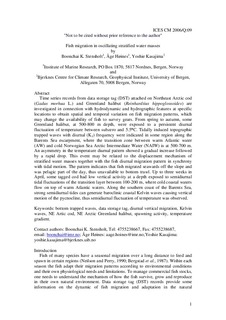| dc.description.abstract | Abstract
Time series records from data storage tag (DST) attached on Northeast Arctic cod
(Gadus morhua L.) and Greenland halibut (Reinhardtius hippoglossoides) are
investigated in connection with hydrodynamic and hydrographic features at specific
locations to obtain spatial and temporal variation on fish migration patterns, which
may change the availability of fish to survey gears. From spring to autumn, some
Greenland halibut, at 500-800 m depth, were exposed to a persistent diurnal
fluctuation of temperature between subzero and 5.5±C. Tidally induced topographic
trapped waves with diurnal (K1) frequency were indicated in some region along the
Barents Sea escarpment, where the transition zone between warm Atlantic water
(AW) and cold Norwegian Sea Arctic Intermediate Water (NAIW) is at 500-700 m.
An asymmetry in the temperature diurnal pattern showed a gradual increase followed
by a rapid drop. This event may be related to the displacement mechanism of
stratified water masses together with the fish diurnal migration pattern in synchrony
with tidal motion. The pattern indicates that fish migrated seawards off the slope and
was pelagic part of the day, thus unavailable to bottom trawl. Up to three weeks in
April, some tagged cod had low vertical activity at a depth exposed to semidiurnal
tidal fluctuations of the transition layer between 100-200 m, where cold coastal waters
flow on top of warm Atlantic waters. Along the southern coast of the Barents Sea,
strong semidiurnal tides can generate baroclinic coastal Kelvin waves causing vertical
motion of the pycnocline, thus semidiurnal fluctuation of temperature was observed.
Keywords: bottom trapped waves, data storage tag, diurnal vertical migration, Kelvin
waves, NE Artic cod, NE Arctic Greenland halibut, spawning activity, temperature
gradient. | en |
